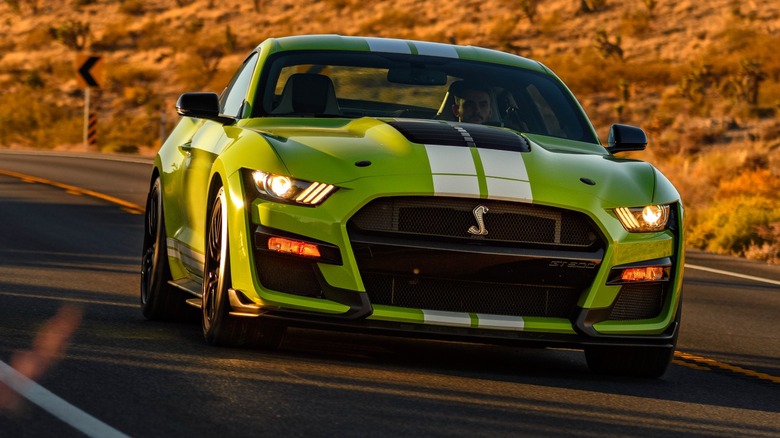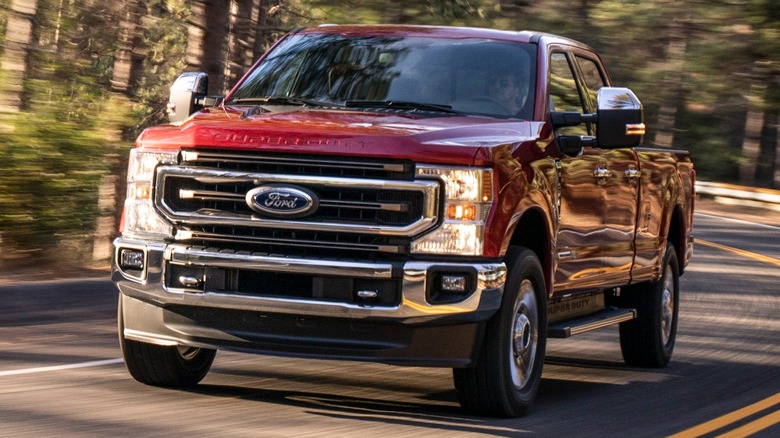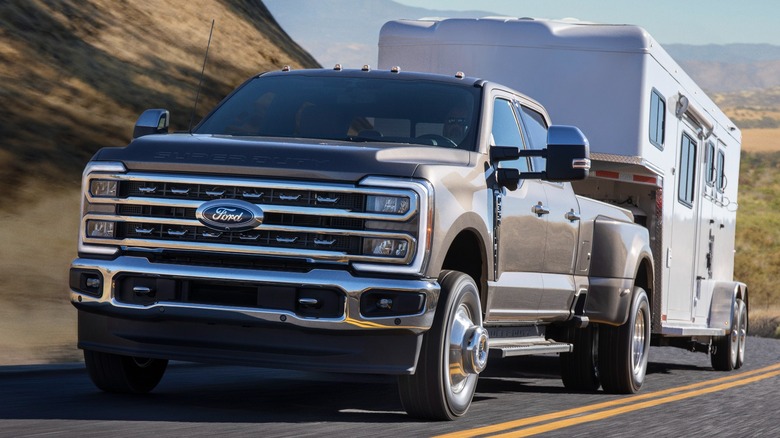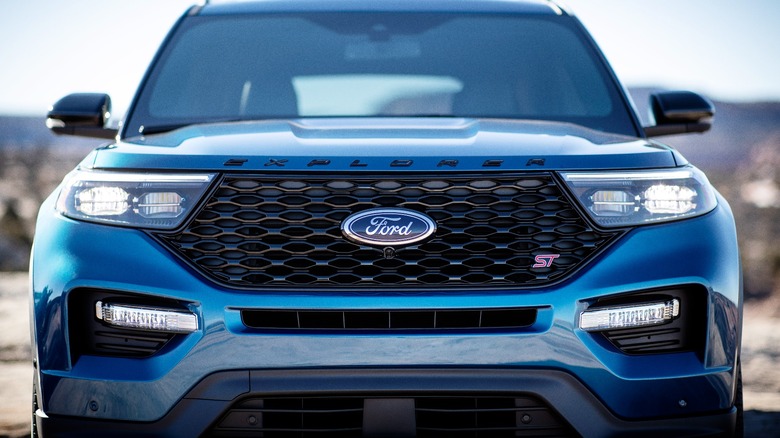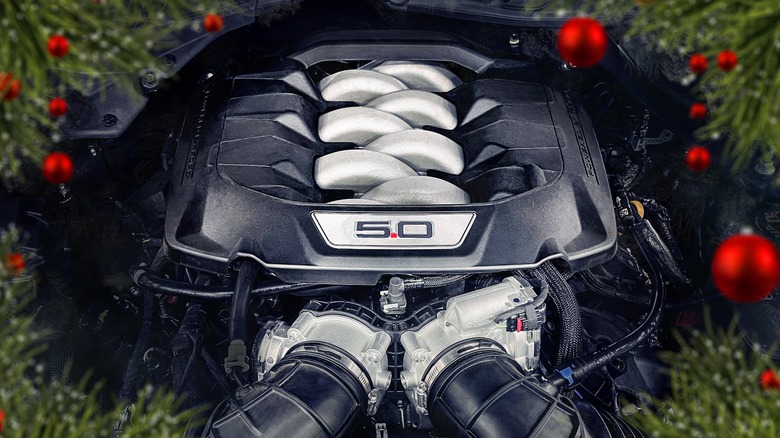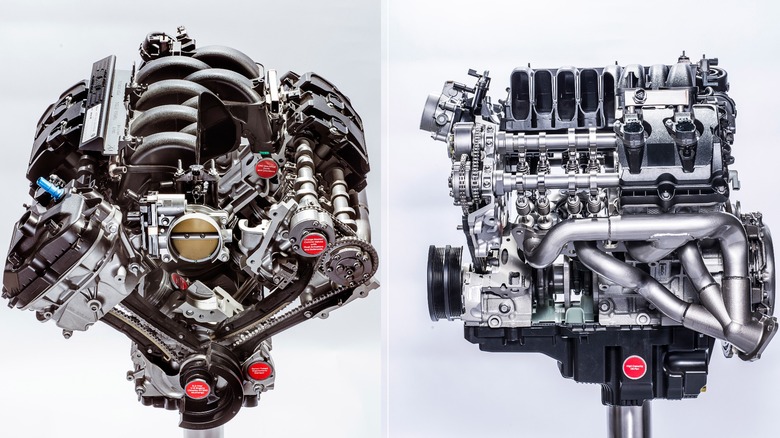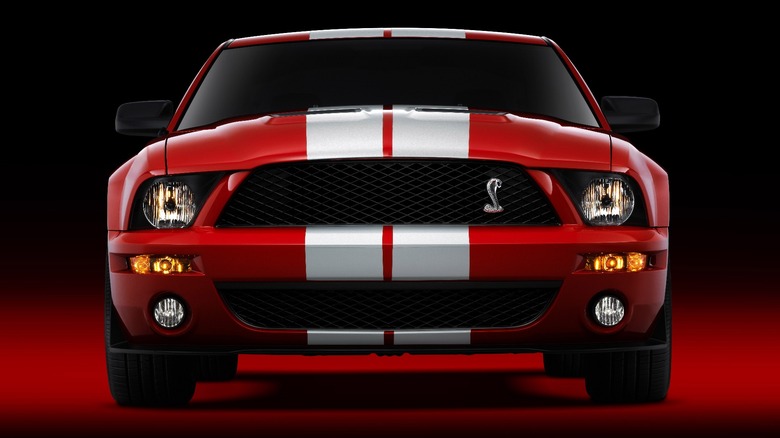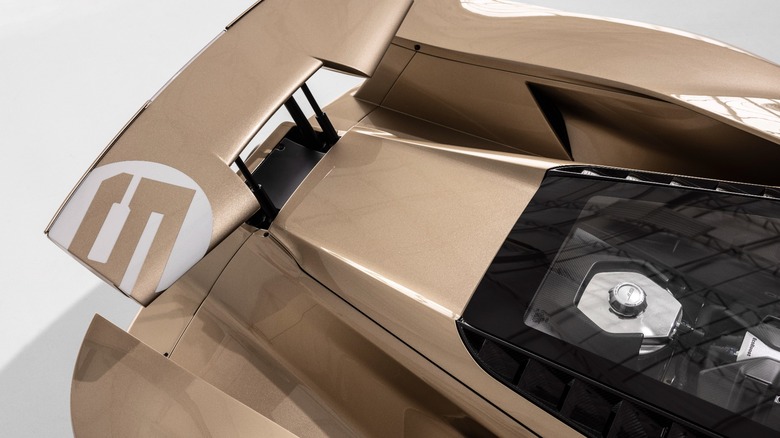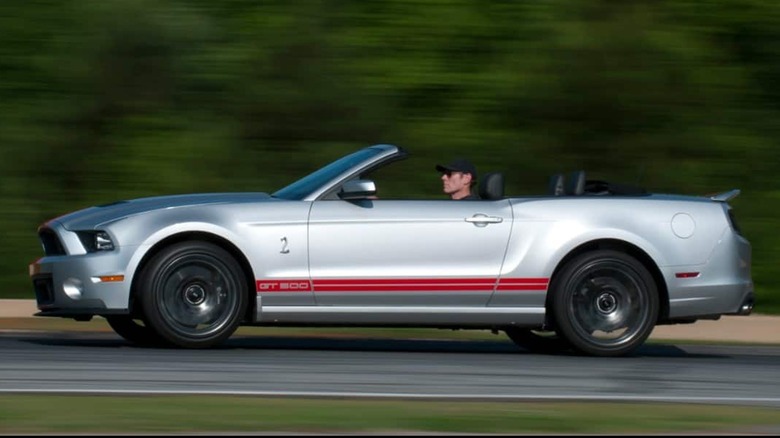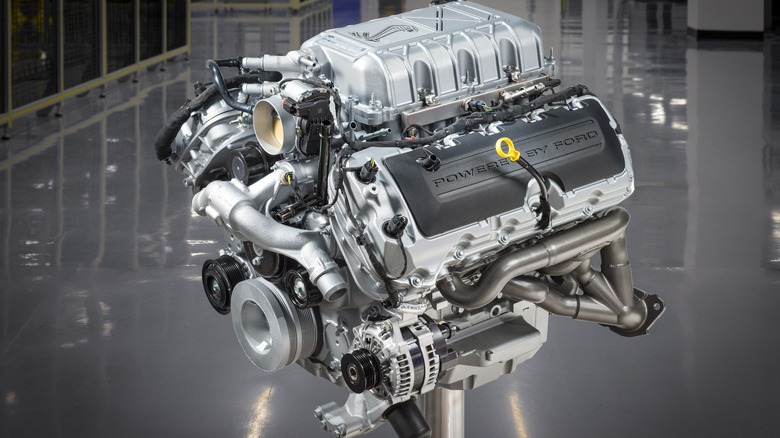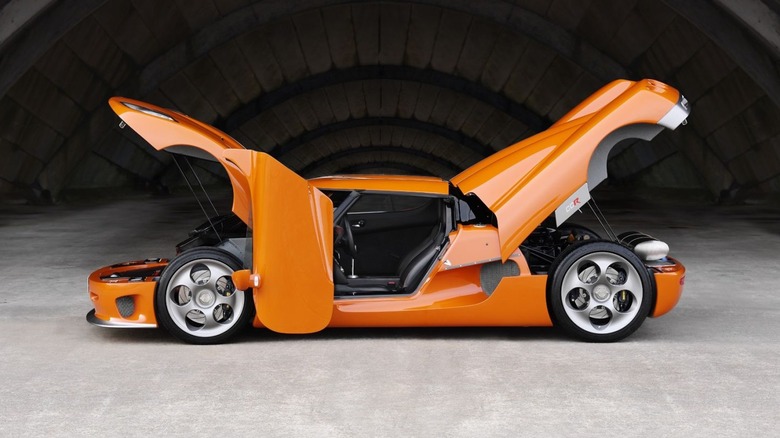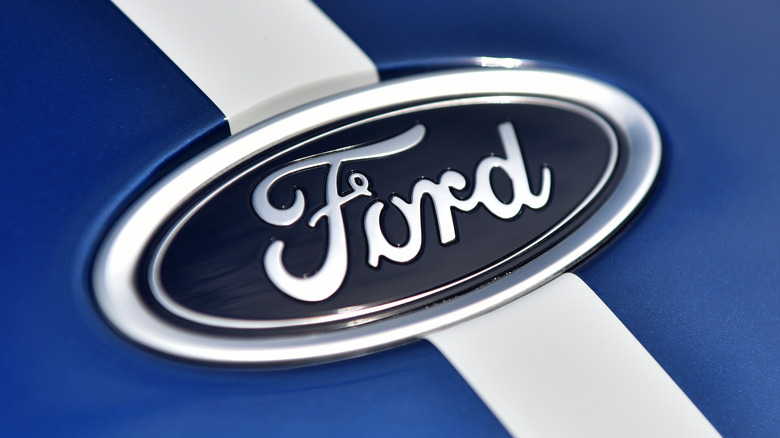10 Of Ford's Most Powerful Engines, Ranked By Horsepower
Ford has a reputation for building muscle, and that muscle extends far beyond the showroom floor. Over the years, Ford has produced memorable vehicles like the Shelby GT350, Shelby GT500, Ford GT supercar, and the all-new Ford F-150 Raptor R pickup truck, to name a few. These are but a testament to Ford's engineering prowess, each with its ludicrous performance that could propel you from 0 to 60 mph in a blur.
We'll be ranking these engines based on the sheer grunt they produce. In addition, we'll delve deeper to find other manufacturers like the Australian outfit Brabham and Swedish automaker Koenigsegg, who came knocking for a taste of the blue oval power. So, hold on as we explore the engineering brilliance behind the powerhouses that make Ford's vehicles sing. Prepare to be surprised not only by the V8 marvels, but also by some V6 contenders that refuse to be left behind. These engines break the 400 horsepower barrier and climb past a staggering 700 horsepower.
7.3-Liter Godzilla V8 – 430 HP
Ford introduced the 7.3-liter Godzilla V8 in 2020 in the Super Duty truck lineup. The 7.3-liter Godzilla is a naturally aspirated gas engine that targets the best horsepower and torque in its class. It produces 430 horsepower and 475 lb-ft of torque, outperforming the available 6.2-liter V8 option. Ford achieves this by using an overhead valve pushrod design and an improved air intake and tuning. While this differs from the common overhead camshaft setup, the Godzilla V8 promises class-leading reliability and fuel economy.
The Godzilla is currently Ford's largest displacement gasoline V8, and it pairs with a 10-speed TorqShift automatic transmission. In medium-duty trucks (F-650 and F-750), the Godzilla V8 pairs with a six-speed TorqShift automatic transmission and produces 325 horsepower and 468 lb-ft of torque. The medium-duty trucks also get a gaseous fuel prep package, which converts the Godzilla V8 to run on propane or CNG. For $8,500, you can get the Godzilla V8 as a crate engine from Ford Performance, matching the performance of the Super Duty trucks.
6.7-Liter Power Stroke Scorpion V8 – 475 HP
The Power Stroke engine family comprises the Lion V6, Puma five-cylinder, and Scorpion V8. These diesel engines power vehicles ranging from sedans to SUVs to vans to trucks. The Scorpion V8 is the most powerful of the lineup, and it's commonly used in the Super Duty truck lineup. Ford introduced the 6.7-liter Power Stroke Scorpion V8 in 2011, boasting better fuel economy and 400 horsepower and 800 lb-ft of torque. This Power Stroke Scorpion V8 had a single sequential turbocharger with a single turbine and dual compressor setup.
Ford further updated it in 2015, introducing a single Garret GT37 turbocharger, which upped the engine's performance to 440 horsepower and 860 lb-ft of torque. In 2020, Ford revised the V8's boost and programming, upping its torque from 935 lb-ft to 1,050 lb-ft, the highest torque output in Ford's lineup. In the Super Duty trucks, the 6.7-liter V8 is available alongside a 6.2-liter and a 7.3-liter gasoline V8s. Fortunately, the Power Stroke Scorpion V8 is the most powerful engine in the lineup, producing 475 horsepower and 1,050 lb-ft of torque.
Like the Godzilla V8, the Power Stroke is only available with a 10-speed TorqShift automatic transmission in the Super Duty trucks. Ford also powers the larger medium-duty trucks with the Godzilla or the Power Stroke Scorpion V8. Here, the detuned Power Stroke Scorpion V8 pairs with a six-speed TorqShift automatic transmission and produces 330 horsepower and 750 lb-ft of torque.
3.0-Liter Twin Turbocharged EcoBoost V6 – 494 HP
The 3.0-liter EcoBoost V6 is a twin-turbocharged gasoline engine that powers SUVs, midsize, and full-size cars. Ford derived this engine from the 2.7-liter EcoBoost by increasing the cylinder bore from 83 to 85.3 mm. Ford made other changes to the 3.0-liter V6, including a longer piston stroke and a cast aluminum block design. Lincoln was the first brand to use the V6 in its 2017 MKZ and Continental sedans, boasting 400 horsepower and 400 lb-ft of torque.
Ford only recently started using the V6 in its vehicles, with the first being the 2020 Explorer. The EcoBoost powered the 2020 Ford Explorer ST, helping make it the most powerful Explorer at the time. Like the Lincoln Continental, the Explorer ST produced 400 hp but upped the torque to 415 lb-ft. This performance bump helped the Explorer ST reach a top track speed of 143 mph. The EcoBoost V6 paired with a 10-speed automatic transmission helps the Explorer ST tow up to 5,600 lbs; 300 pounds more than the base version.
For the 2020 model year, Lincoln also fitted the EcoBoost V6 in the Aviator SUV, matching Ford's performance figures. However, a hybrid Aviator paired an electric motor with the V6 to produce 494 horsepower and 630 lb-ft of torque.
5.0-Liter Coyote V8 – 500 HP
The Coyote V8 is a naturally aspirated engine and part of Ford's modular engine family. The Coyote marked Ford's first use of Twin Independent Variable Cam Timing in a V8 engine, a technology more common in Ford's V6 engines. Ford introduced the Coyote V8 in the 2011 Mustang GT and F-150 pickup truck. The Coyote V8 in the Mustang produced 412 horsepower and 390 lb-ft of torque, helping it compete with the LS3 in the Camaro. While that didn't equate to more power than the Camaro, the Mustang GT was more powerful than its predecessor's 4.6-liter V8 with 315 horsepower and 325 lb-ft of torque.
The engine is paired with a six-speed manual transmission as standard or an optional six-speed automatic. Ford's Coyote V8 was also more fuel-efficient than the Camaro's LS3. It had an EPA fuel economy rating of 18 mpg city, 25 mpg highway, and 20 mpg combined. In 2013, Ford improved the Coyote's output to 420 horsepower and 390 lb-ft of torque, making the Mustang a worthy rival to the Camaro. Over the years, the Coyote V8 engine has been used in multiple Mustangs, including the 2013 Boss 302, which produced 444 horsepower and 380 lb-ft of torque.
For the 2018 model year, Ford increased the Coyote's output to 460 horsepower and 420 lb-ft of torque. This was thanks to Ford's use of direct and port injection, first in a V8 engine. Currently, the Coyote V8 powers the seventh-generation Ford Mustang. The 2024 Mustang Dark Horse produces 500 horsepower and 418 lb-ft of torque, 100 horsepower per liter. This version of the Coyote V8 has a dual throttle body design and an innovative dual air intake box, enabling higher air flow rates to minimize induction loss.
5.2-Liter Voodoo V8 – 526 HP
The Voodoo V8 is a naturally aspirated engine commonly used in the Mustang lineup. It was first used in the 2015 Ford Mustang Shelby GT350 and GT350R, lighter and more track-focused versions of the Mustang. At the time, the hand-built Voodoo V8 was the most powerful naturally aspirated Ford production engine, boasting 526 horsepower and 429 lb-ft of torque. The Voodoo V8 used a flat-plane crankshaft, similar to that used in racing or Ferrari sports cars. The flat-plane crankshaft had a firing order that alternated ignition events, helping improve cylinder exhaust pulse separation.
In addition, the Voodoo V8 was the highest-revving V8 at the time, boasting an 8,250 rpm redline. Besides its high revving character, the Voodoo V8 was Ford's most efficient naturally aspirated engine since it managed 102 horsepower per liter. Ford used digital performance simulations and computer-aided engineering to optimize the design of the Voodoo V8. This configuration helped give the Shelby GT350 and GT350R a distinguished exhaust note, unlike most American V8 engines.
The Voodoo V8 also had the largest single, fast-acting throttle body ever fitted on a Ford engine, measuring 87 mm. Ford paired the Voodoo V8 with a six-speed Tremec TR-3160 manual transmission, specifically engineered for less mass and the engine's high rpm. For the 2015 model year, Ford offered 100 Shelby GT350 models, half of which had the Track package and 50 with the Technology Package. The Shelby GT350R was a rarer version with 37 units, two of which were prototypes.
5.4-Liter Triton V8 – 550 HP
The Triton V8 is part of Ford's modular engine lineup, initially used in SUVs and large trucks. Over the years, this naturally aspirated V8 found its way into vehicles like the Ford Expedition, Ford F-150, and Lincoln Navigator. The Triton V8 first appeared in the 1997 Ford F-Series lineup, boasting 235 horsepower and 330 lb-ft of torque. It was the most potent option in the lineup at the time, with the two 4.2- and 4.6-liter V6 engines producing 210 horsepower. This version of the Trinity V8 used a single overhead cam design, aluminum cylinder heads, and a cast iron engine block. It also featured a forged steel crankshaft, fracture-split powder metal connecting rods, roller finger followers, and multi-port fuel injection.
1999 marked the largest shift of the Trinity V8 engine because of the dual overhead cam design. This variant was first used in the Lincoln Navigator, producing 300 horsepower and 360 lb-ft of torque. Ford started using this version of the Trinity V8 in 2000, appearing in the SVT Mustang Cobra R. The SVT Mustang Cobra R produced 385 horsepower and 385 lb-ft of torque, helping it sprint from 0 to 60 mph in 4.7 seconds, reach a 170-mph top speed, and finish the quarter mile in 13.2 seconds.
The Ford GT and the Shelby GT500 were the next vehicles to use the Triton V8, with the GT producing 550 horsepower and 500 lb-ft of torque. The Shelby GT500 started with 500 horsepower and 480 lb-ft of torque but later upped it to 550 horsepower and 510 lb-ft of torque. While this was the most performance the Trinity V8 offered in Ford vehicles, Brabham pushed it to produce 691 horsepower and 492 lb-ft of torque in the BT62.
3.5-Liter Twin Turbocharged EcoBoost V6 – 647 HP
Despite being a famous Ford engine thanks to its use in the second-generation Ford GT, the 3.5-liter EcoBoost V6 started life in the 2010 Lincoln MKS. This version of the EcoBoost V6 produced 355 horsepower and 350 lb-ft of torque, helping make the MKS quicker without affecting the fuel economy. In the same year, Ford also introduced the engine in the Ford Flex, matching the performance figures of the MKS. Unlike engines like the Voodoo and Triton, which powered specific performance vehicles, this EcoBoost V6 powered supercars, trucks, SUVs, midsize cars, and full-size cars. The most powerful version of the first-generation EcoBoost V6 was introduced in the 2015 Lincoln Navigator. It produced 380 horsepower and 460 lb-ft of torque paired with a six-speed automatic transmission.
Ford introduced the second generation EcoBoost V6 in 2017 to power its supercar, the Ford GT. This engine was also available in the 2017 Ford F-150 and the 2018 Lincoln Navigator. In the 2017 F-150, the V6 produced 375 horsepower and 470 lb-ft of torque. Lincoln got more performance out of the V6, with the Navigator matching the performance of the F-150 Raptor, 450 horsepower and 510 lb-ft of torque. This engine had multiple new features, including a variable displacement oil pump and higher boost turbochargers.
The 2017 Ford GT had the best performance, boasting an impressive 647 horsepower and 630 lb-ft of torque. Despite sharing most of its engine parts with the 2017 Ford F-150 Raptor, the GT featured a new port and direct dual fuel-injection setup. Ford paired the GT with a seven-speed dual-clutch automatic with great driver control and nearly instantaneous gear changes.
5.8-Liter Supercharged Trinity V8 – 662 HP
The Trinity V8 is a supercharged engine from Ford's SVT division, which powered the 2013 to 2014 Ford Shelby GT500. While it is no longer in production, the Trinity V8 shared parts with the Coyote and Triton, including the piston cooling oil jets and camshafts. The SVT division also reworked the cylinder heads to improve coolant airflow, added a five-layer MLS head gasket, increased the compression ratio, and added an over-rev function to increase the redline from 6,250 rpm to 7,000 rpm for up to eight seconds.
The Trinity V8 also used an Eaton 2.3-liter TVS supercharger with up to 14 psi of boost. All these upgrades helped the Trinity V8 produce 662 horsepower and 631 lb-ft of torque. This translated to a quick 0 to 60 mph time of 3.5 seconds and a quarter mile run of 11.6 seconds. These upgrades also helped make the Shelby GT500 more powerful than the 2014 Chevrolet Camaro ZL1, which also had a supercharged 6.2-liter V8 with 580 horsepower and 556 lb-ft of torque.
5.2-Liter Supercharged Predator V8 – 760 HP
The Predator V8 is one of the newest powerplants in Ford's engine lineup. This supercharged V8 engine debuted in 2019, powering the 2020 Ford Mustang Shelby GT500. The hand-built Predator V8 utilized a cross-plane crank, a dual overhead cam design, and a 2.65-liter roots-type supercharger. Unlike the Voodoo V8, the Predator didn't need a flat plane crankshaft since the supercharger added the required performance.
In addition, the Predator V8 had weight-saving wire arc cylinder liners, larger connecting rods, and high-flow aluminum cylinder heads. Underneath the engine was a structural oil pan with a baffle system. The oil pan also helped reduce vibration and add strength. All these improvements translated to 760 horsepower and 625 lb-ft of torque. Ford paired the Predator V8 with a seven-speed Tremec dual-clutch transmission, which, according to Ford, could shift in less than 100 milliseconds.
Besides being the GT500 powertrain, Ford also fitted the Predator V8 in the 2022 Ford F-150 Raptor R. This variant produced 700 horsepower and 640 lb-ft of torque, making the F-150 Raptor R more capable for extreme off-roading. Ford also paired the Predator V8 in the F-150 Raptor R with a 10-speed automatic SelecShift transmission, helping it conquer brutal off-road environments. While we still await to see everything the seventh generation Ford Mustang lineup offers, the Predator V8 is currently the most powerful engine in Ford's lineup.
4.6-Liter Rotex Supercharged Modular V8 – 794 HP
This 4.6-liter engine started as a naturally aspirated V8 used in SUVs, sedans, vans, trucks, and sports cars. The 4.6-liter V8 has been around from 1990 to 2014. One of the first vehicles to feature this engine was the 1991 Lincoln Town Car. It produced 190 horsepower and 260 lb-ft of torque. Despite having a single overhead camshaft design, this version of the 4.6-liter V8 eventually produced a maximum of 265 horsepower and 305 lb-ft of torque in the 2001 Mustang GT Bullitt. Eventually, the engine received a dual overhead camshaft design in 1993, powering the Lincoln Mark VIII. The 4.6-liter V8 produced 280 horsepower and 285 lb-ft of torque in this configuration. This engine had an aluminum block, tumble-style intake ports, fixed runner-length intake manifolds, and new camshaft profiles.
Koenigsegg first used the 4.6-liter V8 in the CC8S, fitting it with a supercharger to produce 655 horsepower and 553 lb-ft of torque. However, the most powerful variant of the 4.6-liter V8 was in the CCR, boasting two superchargers to produce 795 horsepower and 678 lb-ft of torque. In addition to the two Rotrex superchargers, the 4.6-liter V8 had a dry sump and a carbon fiber cam cover. Koenigsegg's upgrades helped the CCR achieve a 0 to 62 mph time of 3.2 seconds, set a quarter mile time of 9 seconds, and reach a top speed of over 242 mph. The CCR's impressive performance helped make it the world's fastest production car in 2005, outperforming the McLaren F1, which had an eight-year record.
Methodology
We relied on horsepower figures directly sourced from Ford and reputable automotive authorities like Lincoln, General Motors, and Koenigsegg to create this ranking of Ford's awe-inspiring engines. We didn't stop there, though. We consulted expert specifications and reviews from outlets like fueleconomy.gov, Ford Performance, Edmunds, Top Gear, PR Newswire, and MotorTrend to understand each engine's capabilities and character better. This multi-faceted approach ensures accuracy while reflecting the true power of each powerplant.
